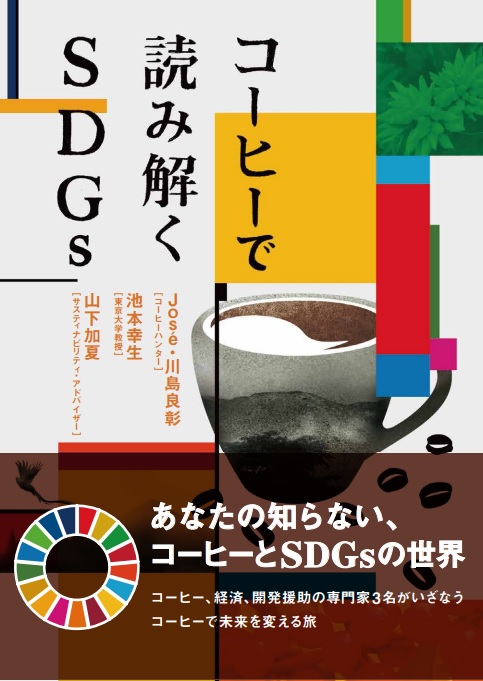
Title
Coffee de yomitoku SDGs (Understanding SDGs with coffee)
Size
287 pages, 188mm x 128mm
Language
Japanese
Released
March, 2021
ISBN
978-4-591-16968-1
Published by
POPLAR Publishing Co., Ltd.
Book Info
See Book Availability at Library
Japanese Page
The Sustainable Development Goals, or SDGs, were adopted at the United Nations Summit in September 2015. There are 17 SDGs comprising 169 targets, to be achieved by 2030.
Although 5 years have passed since the establishment of the SDGs, it seems that people in Japan are not adequately familiar with the goals. Many of them think it is a domestic matter, and SDG-related activities in Japan tend to be nation-oriented. In reality, however, it is a global matter, and we need to think and act globally because Japanese economy is strongly connected to the world.
Coffee is produced in the area called the "coffee belt" between the Tropics of Capricorn and Cancer, most of which belong to developing countries in the South, while the major consumers live in developed countries in the North. Although it is widely known that Brazil is the world's largest coffee exporter, it is not well known that Vietnam is the second-largest. Thus, consumers in Japan as well as other developed countries have little knowledge or interest in how coffee is produced. However, there are many problems in the producing countries. For example, deforestation and environmental destruction may be occurring to clear land for large coffee plantations, and coffee farmers may be living in poverty due to the fall in coffee prices in the international market. If we want to ensure that "no one is left behind," as the SDGs insist, consumers in Japan must pay attention to the producing countries when drinking coffee.
Each of the three authors of this book interacted with coffee farmers in developing countries in different fields and understood that coffee was closely linked to the SDGs. Their idea behind writing this book was that knowing about coffee is a great way to understand what the SDGs are and what we should do.
The structure of this book is in line with the 17 SDGs—each chapter corresponds to a goal, beginning with an explanation of it and its targets and then providing specific examples in the coffee production area. For example, Chapter 3, "Health and welfare brought by coffee," takes Thailand’s Doi Tung coffee as an example; the area called the Golden Triangle in northern Thailand was once a major opium-producing area, and to stop the cultivation of poppy, the source of opium, coffee was introduced as a way to reforestation and eradicate poverty. It is now sold at the University of Tokyo's Communication Center. One of the authors, Jose Kawashima, who is known as "coffee hunter," taught the farmers how to grow coffee to bring its quality on a par with the international standard. Doi Tung coffee is sold at the University of Tokyo because we want people in Japan to know more about coffee, how it is grown in developing countries. After reading this book, when you drink coffee, you will be able to think about how the coffee is connected to the people of the world and environmental problems. Really good coffee isn't just about taste.
(Written by IKEMOTO Yukio, Professor, Institute for Advanced Studies on Asia / 2021)
Table of Contents
1. "Coffee crisis" and poverty
2. Eradication of hunger with coffee production
3. Health and welfare brought by coffee
4. Education brought by coffee
5. Coffee production and gender equality
6. Safe water on coffee plantations
7. Coffee and clean energy
8. The jobs that coffee produces
9. Coffee and innovation
10. Reduce inequality with coffee
11. Coffee and town development
12. Responsibility of producing coffee and responsibility of drinkers
13. Climate change and coffee
14. The rich sea protected by coffee
15. The rich land protected by coffee
16. Equality and justice with coffee
17. Coffee partnership
Conclusion



 Find a book
Find a book

